Abstract
Establishing the manner of death is one of the most challenging tasks for forensic pathologists. We present the case of a 24-year-old woman found dead in the early morning on a flyover. The body was sitting on the ground with the back leaning against a wall. The neck was encircled by a white phone charger cable knotted to the staircase’s handrail. The victim had argued with her boyfriend and tried to jump out of his car while coming home from a wedding party the night before. After that, she left home alone with her phone charger in her hand. Due to self-harm behaviors, the first hypothesis was suicide by hanging. However, the ligature crossed immediately beneath the thyroid cartilage and encircled the neck twice horizontally; the two ends of the cable overlapped, forming a cross-over point in the front-right of the neck. Then, the ligature passed obliquely through the nape, gradually disappearing, forming a gap in the mark. The mark was sharply defined, stiff, yellow, and parchment-like. The investigators performed a three-dimensional scene reconstruction using the Trimble X7 Laser Scanner and the PC-Crash Multibody System. Even though the geometry of the ligature mark in the present case raised doubts about the manner of death, the three-dimensional reconstruction confirmed that the hanging was feasible without any external intervention.
1. Introduction
According to the National Institute of Mental Health, suicide is defined as “death caused by self-direct injurious behavior with intent to die as a result of the behavior” [1]. Suicide is a recurrent variety of unnatural death. The global rate of suicide is around 10.7 per 100,000 individuals [2]. The prevalence of different suicide methods varies according to the availability of harmful tools and socio-cultural acceptability [3]. In Europe and also in Italy, hanging is the most common method of suicide [4].
Hanging is a form of ligature strangulation in which the force applied to the neck is derived from the gravitational drag of the body’s weight or part of the body. A typical method of self-suspension is to attach a thin rope to a high point, such as a ceiling beam or staircase [5]. Airway occlusion occurs either from direct compression of the larynx or trachea or from a lifting of the larynx so that the pharynx is closed by the root of the tongue being pressed against the soft palate and roof of the mouth. Moreover, the pressure on the neck causes the bilateral occlusion of the jugular system and the carotid arteries. This causes a loss of consciousness in the victim. However, the mode of death in hanging can also be bradycardia and heart arrest due to the stimulation of the baroreceptors situated in the carotid sinus.
Homicidal and accidental hanging are described in a only few cases [6]. Accidental hanging is rare in both children and adults. Pediatric hanging is much less common among small children or toddlers who trap their heads in their surrounding environment [7]. Adult accidental hanging can be “voluntary” or “involuntary”. While the latter refers to pure accidental hanging (e.g., incidents during professional or leisure activities), “voluntary” accidental hanging includes hanging resulting from autoerotic asphyxia [8].
Different from hanging, strangulation is a type of mechanical asphyxia due to pressure on the neck by a force other than from the victim’s body weight [5]. Strangulation is common as a homicide method but also during intimate partner violence, domestic violence, and sexual assault [9,10].
As homicidal and accidental hanging are anectodical, the manner of death in hanging is nearly always suicide [11]. However, while examining a suspended body, the medico-legal assessment should also consider homicidal hanging and simulated self-hanging [12]. For example, suspending a victim with a neck ligature should obscure the preceding strangulation [12]. For that reason, any suspended corpse should be carefully examined.
The ligature mark may allow for distinguishing strangulation from hanging [13]. The ligature mark is a common injury in cases of hanging and strangulation. The hanging mark is usually a single mark slanting downwards from the knot to the noose and becomes shallowest near the knot, especially if the noose is knotted with a hold knot [14]. On the other hand, a typical strangulation mark completely encircles the neck many times without gaps, following a horizontal plane overlying the larynx or upper trachea [10].
The environmental features of the scene are essential to piece together the circumstances of the crime. The body’s position, objects within the scene, and organic and inorganic traces should be carefully examined. For example, self-hanging requires proper environmental features to be carried out.
Typical scene documentation methods are handmade sketches, photographs, and videos [15]. Photographs and videos should be coupled with manual measurements of the scene’s perimeter and the objects within it [16]. Even though manual measurements are accepted in practice, they require effort, multiple personnel, and extra time to represent the scene accurately [17].
Geomatic techniques allow for the reconstruction of the crime scene using three-dimensional data acquired quickly and efficiently [18]. Using geomatic techniques, it is also possible to simulate the interaction between objects within the crime scene. A wide variety of 3D techniques and optical sensors are now available. However, the two primary geomatic techniques are photogrammetry and laser scanning [19].
We present the case of a 24-year-old woman found dead with a charging cable tied around her neck and knotted to a staircase’s handrail. The report aims to show how three-dimensional (3D) reconstruction helped establish the manner of death.
2. Case
2.1. Information from the Police Investigation
Around 5:50 a.m., a 24-year-old woman was found dead by two passersby, who tried to save her by cutting the cable. According to witnesses, the victim argued with her boyfriend and tried to jump out of his car while coming home from a wedding party the night before. At approximately 12:30 a.m., she left home alone with her phone charger in her hand. The victim had a history of multiple suicide attempts.
2.2. On-Site Investigation
The body was sitting, the back was leaning against the wall, the legs were bent, and the knees were turned towards the staircase. The face was turned towards the wall (Figure 1).
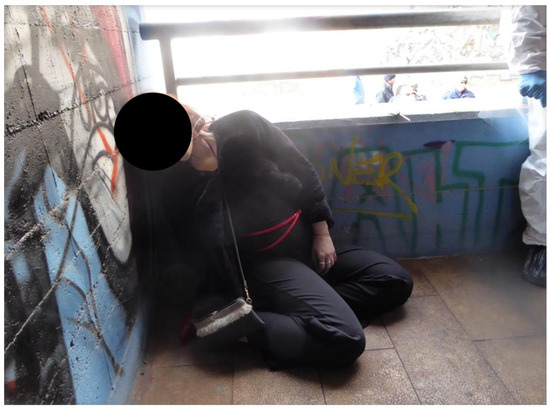
Figure 1.
The body was found sitting near the wall.
The neck was compressed by a ligature consisting of a white phone charger cable knotted to the staircase’s handrail. The ligature crossed immediately beneath the thyroid cartilage and encircled the neck horizontally; the two ends of the cable overlapped, forming a cross-over point in the front-right of the neck. Then, the ligature passed obliquely through the nape of the neck, where it gradually disappeared, forming a gap in the mark. The mark was sharply defined, stiff, yellow, and parchment-like; the cable was 90 cm long. Partially dried saliva was leaking out of the right corner of the mouth, draining down over the chin. Another trace of saliva was found just below the knot on the handrail, 38 cm from the wall (Figure 2 and Figure 3).
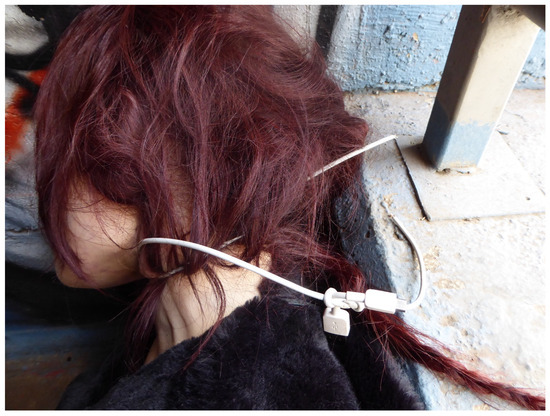
Figure 2.
The ligature was made by a smartphone charging cable.
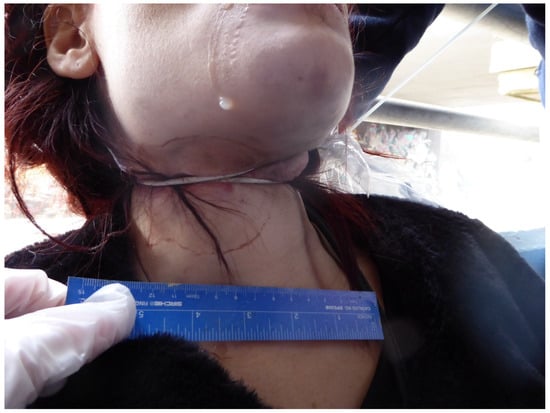
Figure 3.
The ligature and the saliva leakage.
2.3. Autopsy Findings
The autopsy was performed by a 10-year experienced forensic pathologist. The body weighed 67.8 kg and was 162 cm long. The time of death was estimated between 12:00 a.m. and 02:00 a.m. using the Henssge Nomogram [20].
The autopsy showed eyelid hemorrhagic petechiae, soft tissue hemorrhage of the neck muscles, and Brouardel’s sign (cervical prevertebral ecchymosis) [6]. The blood was fluid and dark, and there was polyvisceral congestion.
2.4. Complementary Investigations
The secondary investigations (toxicological and histological examinations) were conducted in the laboratories of the local hospital’s Section of Legal Medicine by experienced operators. The toxicological analysis showed a blood-alcohol level of 1.89 g/L.
The histological samples were stained with hematoxylin and eosin (H&E). Samples of the brain, heart, kidney, and liver showed congestion and no other pathological signs. The samples of the lungs showed congestion and edema. The samples of the neck’s soft tissues had extravasated erythrocytes from damaged blood vessels.
2.5. 3D Reconstruction
A trained engineer reconstructed the scene using the Trimble X7 Laser Scanner and simulated the hanging using the Multibody System of the PC-Crash program. The same professional acquired, stored, and treated the data.
Trimble X7 is a 3D laser scanner similar to others used for surveyors and geospatial professionals.
PC-Crash is a software that is usually employed in reconstructing vehicle collisions. The software is equipped with a rendering engine called the Multibody System, which handles the characterization of bodies represented as ellipsoids connected by joints.
The 3D reconstruction of the scene and the digital simulation of the hanging demonstrated that the victim could hang herself by making a double loop neck ligature.
3. Discussion
In the present case, there was a horizontal mark on the victim’s neck that encircled the neck; the two ends of the cable crossed on the anterior aspects of the neck and proceeded obliquely upward and backward, making the mark more and more superficial until it disappeared on the nape. Hence, several concerns about the manner of death were raised from the geometry of the ligature mark, due to its similarities with a strangulation mark (Figure 4).
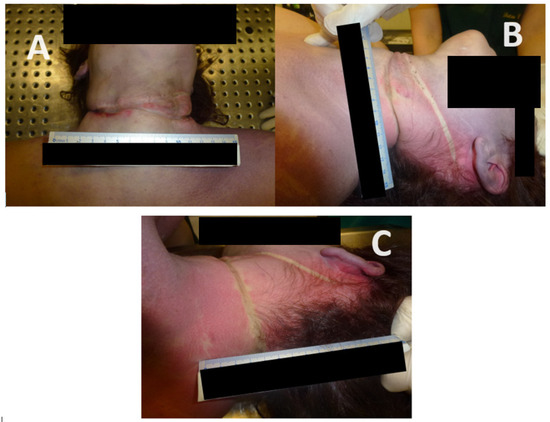
Figure 4.
The ligature mark was taken from the front (A), side (B), and back (C).
A hanging ligature mark is a single mark that does not entirely encircle the neck and becomes most profound opposite the suspension point [14]. On the other hand, a strangulation ligature mark completely encircles the neck horizontally, overlying the larynx or upper trachea, and is continuous and homogeneous [21].
Hence, the shape of the ligature mark, the shortness of the cable, and the apparent difficulty in knotting the cable without external intervention were matters of concern.
The authors decided to use tridimensional reconstruction of the scene and prepare 3D simulation models to make educated guesses about the circumstances of death. The main applications of geomatic techniques in forensics are violent crime scene analysis, traffic collisions, fingerprint analysis, footwear analysis, facial reconstruction, blood pattern analysis, and bullet trajectory analysis [21,22,23,24,25]. To the best of our knowledge, no other case of a 3D reconstruction of a hanging has bene described in the literature.
The general workflow for recreating a crime scene consists of many steps. Laser scanners are typically used to capture the location by firing a laser pulse that strikes a target and returns to the sensor [26]. Modern scanners can record at high-speed capture rates with unprecedented levels of accuracy, while also recording the color information to reconstruct a more realistic scene [27].
In the present case, the Trimble X7 Laser Scanner was used to generate the 3D model of the scene. The scanner performed several scans and generated a set of point clouds from each, which allowed for the creation of a high-reliability 3D model of the building, the objects, and the surfaces [28]. The 3D reconstruction also included the trace of saliva on the handrail, which was located about 38 cm from the landing wall. The woman probably left this trace while she was knotting the cable to the railing (Figure 5).
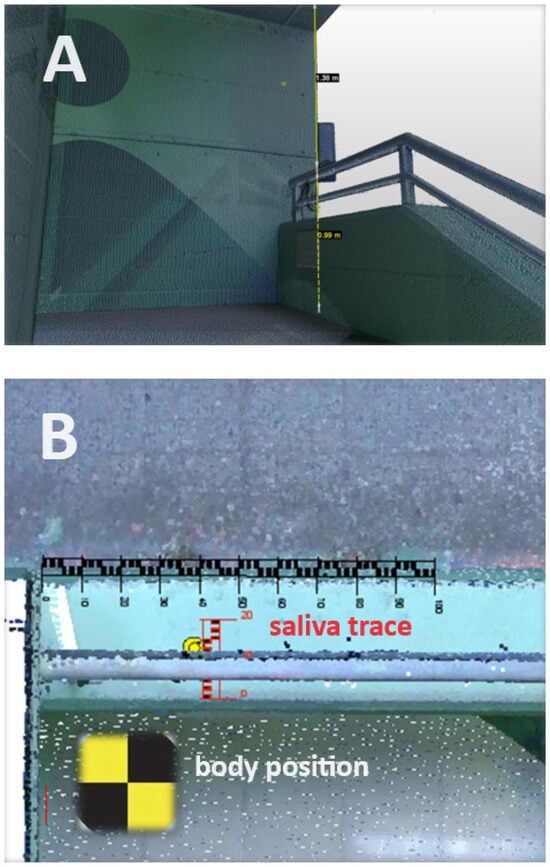
Figure 5.
3D Reconstruction of the scene was performed using the Trimble X7 Laser Scanner (A) and the handrail with the saliva trace (B).
The Multibody System of the PC-Crash software simulates the interaction of a human body model with 3D objects [29]. Each body part is represented by an ellipsoid with its own mass, moment of inertia, and three dimensions. The ellipsoids were connected by kinematic joints (Figure 6).
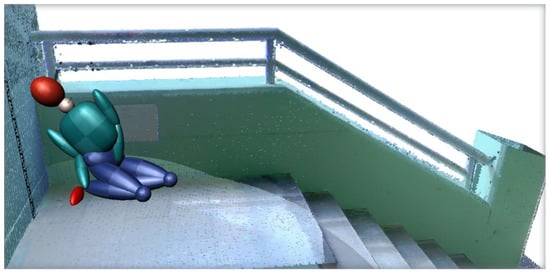
Figure 6.
3D Reconstruction of the victim’s body using the PC-Crash Multibody System.
Different dynamics were simulated with the Multibody System. Usually, in hanging, the noose is tied to a fixed object, and the body weight generates pressure on the neck by pushing the body downward, following gravity. This makes the hanging mark more likely to be unique, oblique, and discontinuous.
In the present case, the simulations confirmed that it was possible to hang using the charging cable without any external help. The 3D reconstruction explained the ligature mark on the victim’s neck. Due to the shortness of the cable (90 cm) and the position of the trace of saliva (just below the handrail, 38 cm from the wall), the most likely position of the woman was standing in front of the railing, bent forward with the neck just above the handrail while tying the cable (Figure 7 and Figure 8).

Figure 7.
Hanging 3D simulation.

Figure 8.
Hanging simulation considering saliva traces.
She probably encircled the neck twice to obtain the effect of a running knot and fastened the free ends of the cable to the handrail. The victim probably left the saliva trace on the wall as she tightened the fixed knot to the railing using her teeth. Then, she probably rested her body sitting on the ground, producing pressure on the neck (see Figure 1).
Hence, the digital reconstruction of the crime was essential to recognize the circumstances of the crime. In the present case, traditional documentation of the on-site investigation would probably have been insufficient. The geomatic techniques give an undeniable advantage compared to traditional photographs or video recording. Using the 3D digital model, it is possible to simulate the interaction between objects within the scene.
On the other hand, forensic photography and video recording remain easy and convenient ways to record many crime scene features. Even though many authors have outlined the bias and uncertainty of forensic digital photography, it is now possible to obtain reliable photos or videos, even without special equipment, using a simple smartphone [30,31].
Even though traditional on-site investigation recording methods cannot be replaced, 3D reconstruction technology should be increasingly employed in forensics.
4. Conclusions
Even though the use of 3D reconstruction is spreading in forensics, according to the best of our knowledge, it is still not employed in cases of hanging. However, hanging may represent a matter of concern for pathologists due to the scarcity of unambiguous signs. Moreover, as hanging requires interaction between the victim and the environment, a careful on-site investigation is crucial to reconstruct and make educated guesses about the manner of death.
In the present case, the digital simulation was crucial to establish the manner of death. The 3D reconstruction allowed the practitioners to simulate the victim’s interaction with such on-site objects and traces. With the help of a trained engineer, the investigators used the Trimble X7 Laser Scanner to map the scene, and then the PC-Crash Multibody System allowed for the simulation of the hanging. Hence, it was possible to examine the hanging dynamics and explain the presence and the position of a trace of the victim’s saliva. The authors finally stated that the neck ligature was possible without any external action.
Traditional documentation of the on-site investigation (using photographs, videos, or hand drawings of the scene) would probably have been insufficient to understand the manner of death.
As such technological aids will constantly improve, their applications in forensic sciences should be studied and progressively tested.
Author Contributions
Conceptualization and writing—original draft preparation, M.B. and L.A.; supervision and writing—review and editing, B.S. and D.F.; investigation, E.M. and A.D.F. All authors have read and agreed to the published version of the manuscript.
Funding
This research received no external funding.
Institutional Review Board Statement
Not applicable.
Informed Consent Statement
Not applicable.
Data Availability Statement
Data sharing is not applicable to this article.
Conflicts of Interest
The authors declare no conflict of interest.
References
- National Institute of Mental Health. Suicide. Available online: https://www.nimh.nih.gov/health/statistics/suicide (accessed on 11 October 2023).
- World Health Organization. Preventing Suicide: A Global Imperative; WHO Press: Geneva, Switzerland, 2014. [Google Scholar]
- Benevento, M.; Mandarelli, G.; Ferorelli, D.; Trotta, S.; Bottari, G.; Caterino, C.; Solarino, B. Complex Suicide by Drowning and Self-Strangulation: An Atypical “Holy” Way to Die. Forensic Sci. Int. Rep. 2021, 3, 100190. [Google Scholar] [CrossRef]
- Crestani, C.; Masotti, V.; Corradi, N.; Schirripa, M.L.; Cecchi, R. Suicide in the Elderly: A 37-Years Retrospective Study. Acta Biomed. 2019, 90, 68–76. [Google Scholar] [CrossRef] [PubMed]
- Saukko, P.; Knight, B. Knight’s Forensic Pathology, 3rd ed.; CRC Press: Boca Raton, FL, USA, 2004. [Google Scholar]
- Gascho, D.; Heimer, J.; Tappero, C.; Schaerli, S. Relevant Findings on Postmortem CT and Postmortem MRI in Hanging, Ligature Strangulation and Manual Strangulation and Their Additional Value Compared to Autopsy—A Systematic Review. Forensic Sci. Med. Pathol. 2019, 15, 84–92. [Google Scholar] [CrossRef] [PubMed]
- Verma, S.K. Pediatric and Adolescent Strangulation Deaths. J. Forensic Leg. Med. 2007, 14, 61–64. [Google Scholar] [CrossRef] [PubMed]
- Nouma, Y.; Ammar, W.B.; Bardaa, S.; Hammami, Z.; Maatoug, S. Accidental Hanging among Children and Adults: A Report of Two Cases and Review of the Literature. Egypt. J. Forensic Sci. 2016, 6, 310–314. [Google Scholar] [CrossRef]
- Mcquown, C.; Frey, J.; Steer, S.; Fletcher, G.E.; Kinkopf, B.; Fakler, M.; Prulhiere, V. Prevalence of Strangulation in Survivors of Sexual Assault and Domestic Violence. Am. J. Emerg. Med. 2016, 34, 1281–1285. [Google Scholar] [CrossRef] [PubMed]
- Patch, M.; Farag, Y.M.K.; Anderson, J.C.; Perrin, N.; Kelen, G.; Campbell, J.C. United States ED Visits by Adult Women for Nonfatal Intimate Partner Strangulation, 2006 to 2014: Prevalence and Associated Characteristics. J. Emerg. Nurs. 2021, 47, 437–448. [Google Scholar] [CrossRef] [PubMed]
- Sharma, L.; Khanagwal, V.P.; Paliwal, P.K. Homicidal Hanging. Leg. Med. 2011, 13, 259–261. [Google Scholar] [CrossRef]
- Pollak, S.; Thierauf-Emberger, A. Homicidal Assault to the Neck with Subsequent Simulation of Self-Hanging. Forensic Sci. Int. 2015, 253, e28–e32. [Google Scholar] [CrossRef]
- Mohanty, M.K.; Rastogi, P.; Kumar, G.P.; Kumar, V.; Manipady, S. Periligature Injuries in Hanging. J. Clin. Forensic Med. 2003, 10, 255–258. [Google Scholar] [CrossRef]
- Mansueto, G.; Feola, A.; Zangani, P.; Porzio, A.; Carfora, A.; Campobasso, C. Pietro A Clue on the Skin: A Systematic Review on Immunohistochemical Analyses of the Ligature Mark. Int. J. Environ. Res. Public Health 2022, 19, 2035. [Google Scholar] [CrossRef] [PubMed]
- Berezowski, V.; Mallett, X.; Moffat, I. Geomatic Techniques in Forensic Science: A Review. Sci. Justice 2020, 60, 99–107. [Google Scholar] [CrossRef] [PubMed]
- Gardner, R.M.; Krouskup, D. Practical Crime Scene Processing and Investigation; CRC Press: Boca Raton, FL, USA, 2018. [Google Scholar]
- Berezowski, V.; Keller, J.; Liscio, E. 3D Documentation of a Clandestine Grave: A Comparison between Manual and 3D Digital Methods. J. Assoc. Crime Scene Reconstr. 2018, 22, 23–37. [Google Scholar]
- Zancajo-Blázquez, S.; Lagüela-López, S.; González-Aguilera, D.; Martínez-Sánchez, J. Segmentation of Indoor Mapping Point Clouds Applied to Crime Scenes Reconstruction. IEEE Trans. Inf. Forensics Secur. 2015, 10, 1350–1358. [Google Scholar] [CrossRef]
- Zancajo-Blazquez, S.; Gonzalez-Aguilera, D.; Gonzalez-Jorge, H.; Hernandez-Lopez, D. An automatic image-based modelling method applied to forensic infography. PLoS ONE 2015, 10, e0118719. [Google Scholar] [CrossRef] [PubMed]
- Henssge, C.; Althaus, L.; Bolt, J.; Freislederer, A.; Haffner, H.T.; Henssge, C.A.; Hoppe, B.; Schneider, V. Experiences with a Compound Method for Estimating the Time since Death. I. Rectal Temperature Nomogram for Time since Death. Int. J. Legal Med. 2000, 113, 303–319. [Google Scholar] [CrossRef] [PubMed]
- Schiraldi, M.; Raniero, D. Unusual Ligature Mark after Strangulation and Skin Maceration. Aust. J. Forensic Sci. 2023, 1–9. [Google Scholar] [CrossRef]
- Maneli, M.A.; Isafiade, O.E. 3D Forensic Crime Scene Reconstruction Involving Immersive Technology: A Systematic Literature Review. IEEE Access 2022, 10, 88821–88857. [Google Scholar] [CrossRef]
- Colard, T.; Delannoy, Y.; Bresson, F.; Marechal, C.; Raul, J.-S.; Hedouin, V. 3D-MSCT Imaging of Bullet Trajectory in 3D Crime Scene Reconstruction: Two Case Reports. Leg. Med. 2013, 15, 318–322. [Google Scholar] [CrossRef]
- Buck, U. 3D Crime Scene Reconstruction. Forensic Sci. Int. 2019, 304, 109901. [Google Scholar] [CrossRef]
- Buck, U.; Naether, S.; Räss, B.; Jackowski, C.; Thali, M.J. Accident or Homicide–Virtual Crime Scene Reconstruction Using 3D Methods. Forensic Sci. Int. 2013, 225, 75–84. [Google Scholar] [CrossRef]
- Sieberth, T.; Dobay, A.; Affolter, R.; Ebert, L. A Toolbox for the Rapid Prototyping of Crime Scene Reconstructions in Virtual Reality. Forensic Sci. Int. 2019, 305, 110006. [Google Scholar] [CrossRef]
- Raneri, D. Enhancing Forensic Investigation through the Use of Modern Three-Dimensional (3D) Imaging Technologies for Crime Scene Reconstruction. Aust. J. Forensic Sci. 2018, 50, 697–707. [Google Scholar] [CrossRef]
- Cunha, R.R.; Arrabal, C.T.; Dantas, M.M.; Bassanelli, H.R. Laser Scanner and Drone Photogrammetry: A Statistical Comparison between 3-Dimensional Models and Its Impacts on Outdoor Crime Scene Registration. Forensic Sci. Int. 2022, 330, 111100. [Google Scholar] [CrossRef]
- Fatzinger, E.; Landerville, J.; Tovar, J.; Nguyen, B. Validation of a PC-Crash Multibody Sport Bike Motorcycle Model. SAE Int. J. Adv. Curr. Pract. Mobil. 2021, 3, 1682–1914. [Google Scholar] [CrossRef]
- Robinson, E.M. Crime Scene Photography; Academic Press: Cambridge, MA, USA, 2016. [Google Scholar]
- Duncan, C.D. Advanced Crime Scene Photography; CRC Press: Boca Raton, FL, USA, 2023. [Google Scholar]
Disclaimer/Publisher’s Note: The statements, opinions and data contained in all publications are solely those of the individual author(s) and contributor(s) and not of MDPI and/or the editor(s). MDPI and/or the editor(s) disclaim responsibility for any injury to people or property resulting from any ideas, methods, instructions or products referred to in the content. |
© 2023 by the authors. Licensee MDPI, Basel, Switzerland. This article is an open access article distributed under the terms and conditions of the Creative Commons Attribution (CC BY) license (https://creativecommons.org/licenses/by/4.0/).